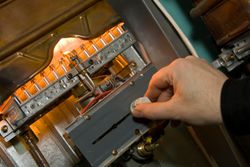
Keeping your home comfortable through the colder months requires an efficient furnace with the right features for your space. However, with all of the different types of systems offered by manufacturers, choosing the right furnace for your home can seem overwhelming. Here’s what you should know about the most common furnace systems to help you make a decision.
What Are the Most Common Types of Furnaces?
1. Forced-Air Systems
In a forced-air system, a central unit heats the air, which is then pumped into the house through a series of ducts. These systems can run on gas, oil, or electricity and generally heat homes more quickly than other options. However, forced-air systems can dry out the atmosphere inside the home, which some people find uncomfortable.
2. Steam Furnaces
 Instead of heating air, boilers use flame or electricity to heat water, which is when pumped through pipes or radiators. Many people prefer the comfort of radiant heat, although they typically don’t respond quickly to rapidly changing temperatures.
Instead of heating air, boilers use flame or electricity to heat water, which is when pumped through pipes or radiators. Many people prefer the comfort of radiant heat, although they typically don’t respond quickly to rapidly changing temperatures.
3. Heat Pumps
Heat pumps are innovative systems that provide air conditioning in the summer and warm your house in the winter. Instead of creating warmth, heat pumps use refrigerant to transfer hot air from one area to another. These are among the most energy-efficient home heating solutions, but they’re generally less effective in environments with extreme temperatures.
4. Floor & Wall Heaters
Most floor and wall heaters are designed to warm a single room—or both areas on either side of a partition. Some models consist of a single furnace that’s placed underneath the floor, which releases heat that warms the room above.
Choosing the right furnace is especially important in Wisconsin, with its notoriously long and bitter winters. Since 1985, the certified experts at Donovan & Jorgenson have helped homeowners throughout New Berlin, West Allis, and Mukwonago keep their homes comfortable all year-round, with options from some of the top manufacturers in the industry. Visit their website to learn more about their gas and oil furnace options, and follow their Twitter page for updates and news.
About the Business
Have a question? Ask the experts!
Send your question

